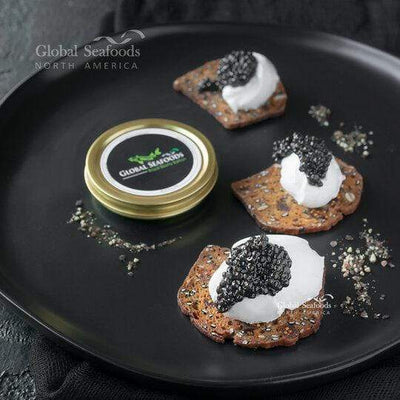Why Investing in Beluga Caviar Is a Luxurious and Profitable Choice

Beluga Caviar Is a Worthy Investment
Beluga caviar, the epitome of luxury and refinement, is more than just a delicacy; it’s a symbol of sophistication and wealth. Often referred to as “black gold,” this rare treat has become an investment choice for connoisseurs and collectors alike. But what makes Beluga caviar so special? Is it worth the price tag, and how can you maximize its value?
In this detailed guide, we’ll explore the world of Beluga caviar, from its unmatched flavor profile to tips for storing, serving, and pairing. We’ll also answer your most pressing questions and provide expert insights into why Beluga caviar is a worthy investment for your palate and portfolio.
For a deeper dive into the luxurious world of caviar, check out Global Seafoods’ YouTube channel for tips and inspiration.
What Is Beluga Caviar?
The Origin of Beluga Caviar
Beluga caviar comes from the Beluga sturgeon (Huso huso), a fish native to the Caspian Sea. Known for its large eggs and buttery texture, it’s considered the finest and rarest type of caviar in the world. The Beluga sturgeon can take up to 20 years to mature, making its roe both a time-intensive and highly prized delicacy.
Why Is It So Expensive?
According to the Caviar Council, Beluga caviar's price reflects its rarity, quality, and the meticulous process required for harvesting and production. Sustainable farming practices and government regulations further increase its value.
The Value of Beluga Caviar as an Investment
1. A Symbol of Prestige
Beluga caviar is often associated with wealth, power, and exclusivity. Serving it at an event or gifting it is a statement of luxury.
2. Longevity and Preservation
When properly stored, Beluga caviar retains its quality for an extended period, making it a viable investment for long-term enjoyment or resale. Learn how to store premium caviar from Global Seafoods’ selection.
3. Rising Demand
As global affluence increases, so does the demand for premium caviar. According to Forbes, “Rare foods like Beluga caviar are increasingly viewed as alternative assets, comparable to fine wine or art.”
How to Serve Beluga Caviar
The Dos and Don'ts of Serving Beluga Caviar
Do Store It Properly
- Keep the caviar refrigerated at 28–32°F (-2 to 0°C) in its original tin.
- Avoid freezing, as this can damage the eggs and alter the flavor.
Do Use Non-Metallic Utensils
- Serve caviar with a mother-of-pearl spoon to avoid any metallic aftertaste.
Do Pair with Light Accompaniments
- Traditional accompaniments include:
- Blinis
- Toast points
- Neutral crackers
You can also enhance the experience with garnishes like:
- Chopped egg whites and yolks
- Chives
- Crème fraîche
For more pairing ideas, explore Ossetra Sturgeon Caviar or Wild Sturgeon Black Caviar.
Don’t Make These Common Mistakes
Don’t Serve It Too Cold
Serving caviar at temperatures below 40°F (4°C) can numb your palate, muting its delicate flavor.
Don’t Use Metal Spoons or Dishes
Metal reacts with caviar, compromising its taste. Always opt for glass, porcelain, or mother-of-pearl.
Don’t Overdo the Portions
A small amount—typically 1–2 ounces per person—is all you need to savor its rich taste.
Expert Pairings for Beluga Caviar
1. Drinks
While champagne is a traditional choice, its acidity can overshadow the flavor of caviar. Instead, opt for:
- Vodka (chilled and unflavored)
- Dry white wines like Sancerre or Chablis
2. Alternative Caviar Options
Interested in trying other types of caviar? Explore Siberian Sturgeon Caviar or California White Sturgeon Caviar for unique flavor profiles.
FAQs About Beluga Caviar
1. Can I Freeze Beluga Caviar?
No, freezing can damage the eggs and alter their texture. Store it in the refrigerator instead.
2. How Long Does Caviar Last?
Unopened caviar can last up to four weeks if refrigerated properly. Once opened, consume within 48 hours for optimal freshness.
3. What Is the Best Way to Serve Caviar?
Serve it chilled on a bed of crushed ice with neutral accompaniments. Use non-metallic serving utensils to preserve its flavor.
4. Why Is Beluga Caviar So Rare?
Beluga sturgeons are slow to mature and heavily regulated due to overfishing. This makes their roe one of the most exclusive and expensive delicacies.
Explore More
Looking for alternative options? Check out these luxury caviar products:
For videos on storing, serving, and enjoying caviar, subscribe to Global Seafoods’ YouTube Channel.
Conclusion
Beluga caviar isn’t just food—it’s an investment in luxury, taste, and prestige. Whether you’re enjoying it for its buttery flavor or leveraging its rarity as an asset, understanding the nuances of Beluga caviar will elevate your experience.
From proper storage and serving techniques to ideal pairings, this guide has covered everything you need to know to make the most of your caviar purchase. Ready to explore the world of caviar? Start your journey with Global Seafoods’ premium collection.
Also in News

How to Make Sea Bream Sushi With Dry-Aged Tuna & Crab Roll — Step-by-Step With Chef Joshua
A complete guide to making Sea Bream sushi at home, including filleting, curing, slicing, and building a Dry-Aged Tuna & Crab sushi roll. Chef Joshua shares professional tips for restaurant-quality results.

Boiled Crab for Game Night: Everything You Need for a Perfect Seafood Party
Take your game night to the next level with a Boiled crab party. Learn the best recipes, cooking tips, and hosting hacks for a memorable seafood feast.

Boiled Crab for Date Night: A Romantic Guide to the Perfect Seafood Feast
Make your next date night unforgettable with a romantic Boiled crab experience. This guide covers everything you need to know, from ambiance to the best crab varieties.

